Abstract
Location-based services are now playing an integral role in the development of emerging industries, such as the Internet of Things, artificial intelligence and smart cities. Although GPS, Beidou and other satellite positioning technologies are becoming more and more mature, they still have certain limitations. In order to meet the needs of high-precision positioning, wireless positioning is proposed as a supplementary technology to satellite positioning, in which the Received Signal Strength Indication (RSSI) is one of the most popular positioning methods. In this paper, the application scenarios, evaluation methods and related localization methods of wireless positioning based on RSSI are studied. Secondly, the relevant optimization methods are analyzed and compared from different angles, and the methods of RSSI data acquisition are described. Finally, the existing problems and future development trends in RSSI positioning methods are expounded, which has certain reference significance for further research on RSSI localization.
1. Introduction
With the rapid development of artificial intelligence and information technology, location-based services have become one of the basic needs of people’s daily life [1]. As a mature positioning technology in an outdoor environment, the Global Navigation Satellite System (GNSS) has achieved sub-meter positioning accuracy, which can provide more accurate positioning services [2]. However, GNSS and the Global Positioning System (GPS) are still unable to obtain accurate positions in an indoor environment [3]. At the same time, people’s increasingly frequent indoor activities create a stronger demand for wireless positioning technology [4]. Different from the outdoor environment, indoor signal is severely attenuated due to factors such as occlusion, which is not conducive to achieving more accurate positioning [5]. Therefore, wireless positioning using ultrasonic, WIFI, Bluetooth, radio frequency identification, infrared and other technologies has gradually become the focus of attention [6]. As a common measurement index, RSSI can realize positioning without additional measurement means, such as laser, camera, magnetic, ultrasonic acoustic sensor or lidar [7], thus reducing positioning cost and energy consumption [8]. However, the original RSSI signal from the wireless access point is susceptible to obstacles, signal fluctuations, noise, environmental changes, non-line-of-sight communication, multipath interference, etc. [9,10,11].
The main contributions of this article are as follows:
- The application scenarios and existing problems of wireless location are described, and the importance of wireless location is explained.
- The commonly used RSSI positioning methods, data acquisition methods and evaluation methods are summarized, which provides convenience for beginners.
- The improved methods based on RSSI positioning are analyzed, which points out the right direction for researchers.
The RSSI positioning method is more popular than other positioning methods due to its low cost and low power consumption [12]. The main contents and contributions of the thesis are organized and shown below. In Section 1, the Wireless positioning application scenarios are reviewed. In Section 2, a more detailed description of the evaluation method is given based on wireless positioning. In Section 3, The common positioning methods are described in detail. In Section 4, the optimization method for wireless positioning is mainly introduced. In Section 5, the data acquisition methods are explained. Finally, the challenges and future development trends of wireless positioning are summed up in Section 6 and Section 7, respectively. The aforementioned information can offer convenience for novices and serve as a guide for further research.
2. Application
The technology of location-based services has entered every aspect of people’s lives and is quietly changing every aspect. Wireless positioning technology, as a supplement to satellite positioning, has been of wide concern. Figure 1 shows the application scenario of wireless positioning technology. It can be seen from Figure 1 that wireless positioning technology has been widely used in the fields of precision advertising push, emergency rescue, emergency evacuation, auxiliary architectural design, intelligent transportation, etc. [13,14,15], to make up for the shortcomings of satellite positioning. As the output data is used by certain devices for further applications, the performance of the devices will be degraded if the positioning accuracy is not high enough. For example, for safety management at construction sites, researchers have developed hazard warning systems that combine positioning, imaging, and alerting techniques to warn workers when they are approaching dangerous areas. If the positioning accuracy is low, false or delayed, alarms may occur [16].
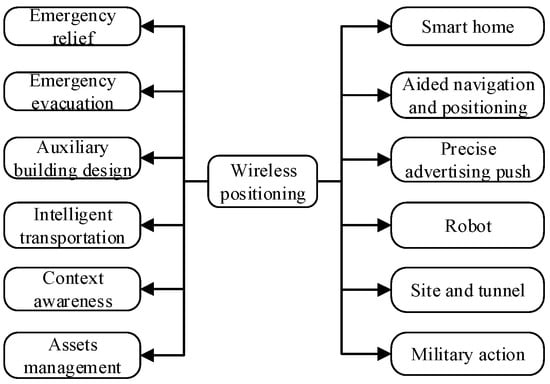
Figure 1.
Wireless positioning application scenario diagram.
3. Evaluation Methods
Accuracy is an important index that reflects the quality of the output position data. The Euclidean distance between the estimated and the actual is usually used as a measure of the positioning accuracy [17], which is detailed in Equation (1):
in which, x, y, z, respectively, represent the coordinates of the measured value in three-dimensional space, and , , represent the real coordinates in three-dimensional space, which is similar to the expression of absolute error in the following Equation (2):
where p denotes the measured value and denotes the true value. The average error is the result of averaging the Euclidean distance between the estimated value and the actual value after multiple measurements, as shown in Equation (3). Both this and distance root mean square can effectively measure the validity of the algorithm:
Among these, xi, yi, and zi denote three values of the three-dimensional space coordinates of the measured value, and , , and denote three values of the three-dimensional space coordinates of the true value, respectively. In addition to the average error and the root mean square of the distance, the effectiveness of the algorithm can be evaluated using the , , approach.
In addition, there are also variance, standard deviation [18] and correlation coefficient for evaluating the positioning effect, as shown in Equations (4)–(6).
Variance:
Standard deviation:
Correlation coefficient:
The metrics for evaluating the positioning effect also encompass power consumption, cost, and algorithm complexity. The power consumption is mainly generated by communication, and algorithms with high complexity also consume energy [19]. Cost is one of the decisive criteria for choosing an indoor positioning system, mainly used to measure the total cost in money and time resources required to achieve the acquisition, establishment and maintenance stages of indoor positioning services. The coverage rate can also be counted as a part of the cost. Equation (7) is the coverage rate calculation formula, which can also reduce the positioning cost by covering a larger space with fewer devices [20]. The response time for positioning is also an important indicator of the positioning effect. A longer response time may lead to a delay in the positioning output result, thus affecting the positioning effect [21].
4. Positioning Method
Ranging-based positioning mainly utilizes the principle that RSSI decreases with increase in distance; from Equation (1), it can be seen that the difficulty in estimating the coordinates of the test point using this method lies in the accurate calculation of the distance between the test point and the reference point, otherwise, large estimation errors will be caused. Signal propagation in the medium is often accompanied by scattering, diffraction, reflection, etc. This results in signal fluctuations as shown in Figure 2, which are extremely unfavorable to positioning. Therefore, a large number of studies are devoted to improving the accuracy of the measurement of distance [22]. Figure 2 shows the relationship between WI-FI RSSI and the distance of the tested mobile phone. According to previous studies, it can be seen that the relationship is as follow in Equations (8) and (9) [23].
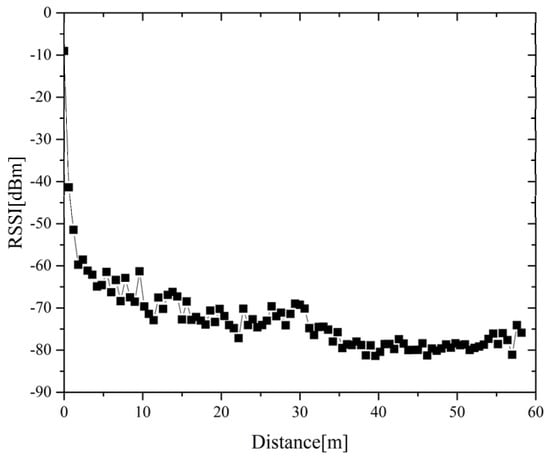
Figure 2.
The relationship between RSSI of WI-FI and the distance of the test cell phone.
One step further:
where d denotes the distance to be estimated, and P(d0) is the RSSI measurement of d0 at the reference distance, which can usually be d0 as 1 m [24].
The distance from the point to be measured to the reference point can also be calculated using the Time of Arrival (ToA) method as in Equation (10) [25]:
where c is the electromagnetic wave propagation speed 3 × 108 m/s, and t is the time at which the transmitting node sends the electromagnetic signal to reach the receiving node; it is known from the method of calculating the distance by the Time of Arrival that it requires high time synchronization between the transmitting node and the receiving node. The probability density function of Pij for measuring the strength of the signal sent by node i to node j can be expressed as [26]:
in which is the maximum likelihood estimation of the distance dij given the received signal strength pij.
In order to better describe the positioning, the fixed WIFI and other devices in the building are usually expressed as “access points” or “anchor nodes”, from which the mobile device obtains the RSSI value [27]. Figure 3 shows the basic architecture of RSSI-based positioning. The basic architecture of RSSI-based positioning can be categorized into two types. One is to complete RSSI data collection on the mobile and carry out the position estimation on an external server, as shown in Figure 3a. The other is to complete RSSI data collection and position estimation directly on the mobile, as shown in Figure 3b.
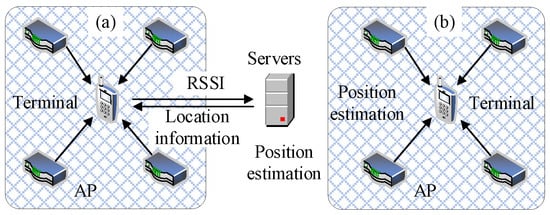
Figure 3.
Basic architecture of RSSI-based positioning. (a) The data is received on the mobile terminal and the external server performs position estimation; (b) Complete data reception and position estimation on mobile terminal.
4.1. Based on Ranging
Based on the exponential attenuation of RSSI with the change in distance, methods including trilateral positioning, triangulation positioning and arrival time difference are derived. These methods are easy to compute but are usually more significantly affected by issues such as signal multipath and non-line-of-sight distance [28].
4.1.1. Trilateral Positioning Method
Figure 4 shows the schematic diagram of trilateral positioning [29]. Known (x1, y1), (x2, y2), (x3, y3) coordinates of three points and (xi, yi) to their distance were d1, d2, d3. According to the Euler distance calculation method, the equations shown in 11 can be listed, and then the coordinates (xi, yi) can be obtained by solving the equations. In [30], the RSSI signal of BLE is used to adopt trilateral positioning and mean filtering to design and develop an Android application for positioning navigation, which can be used in libraries to help visitors quickly find the position of the shelf where the desired book is located.
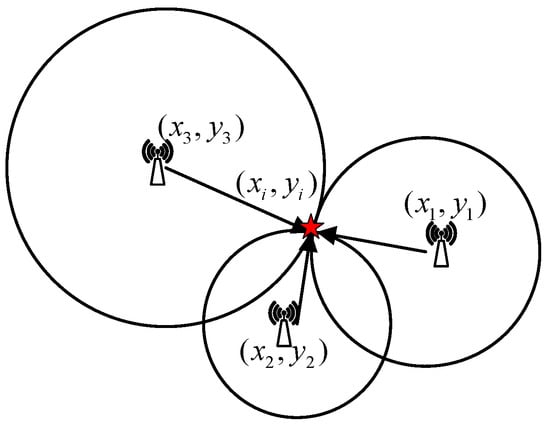
Figure 4.
Three-point positioning schematic.
In Equation (11), the distance from to the three points can be established by modeling between RSSI and distance.
4.1.2. Triangulation Method
The triangulation positioning method utilizes the geometric properties of triangles to position the target and estimate the unknown point coordinates by acquiring the angle between the position node and the given AP via the sensor [24]. Figure 5 shows the principal diagram of triangulation. It is known that the coordinates of AP1 and AP2 are (x1, y1) and (x2, y2), the equations shown in Equation (12) can be listed according to the geometric relationship, then the coordinates of the position nodes can be solved by Equation (12).
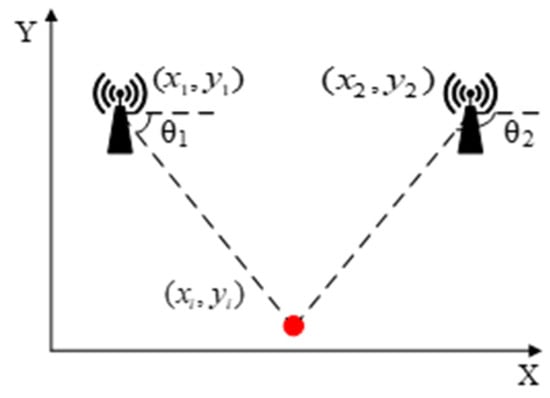
Figure 5.
Triangulation schematic diagram.
Assuming one of the APs as the coordinate origin, the following equation can be simplified to:
Triangulation utilizes the angle of arrival of the radio frequency signal observed by the receiver, which does not require synchronization between the transmitter and the receiver but requires the use of an antenna array at each receiver for DOA estimation, which increases positioning cost and requires greater power consumption [31].
4.1.3. Time Difference of Arrival
Figure 6 shows the schematic diagram of time-of-arrival position estimation. Time Difference of Arrival (TDoA) is a modified version of ToA. Instead of measuring the time it takes for the signal to reach the target position from the AP, this method measures the time difference between the arrival of the signal and the target position. It is relatively easy to implement since only relative time needs to be measured. However, the Line of Sight (LOS) condition is still preferred for TDoA. The algorithm that combines TDoA with Angle of Arrive (AoA) is also an example of hybridization of indoor positioning principles [32]. The computational equations are shown in Equation (13).
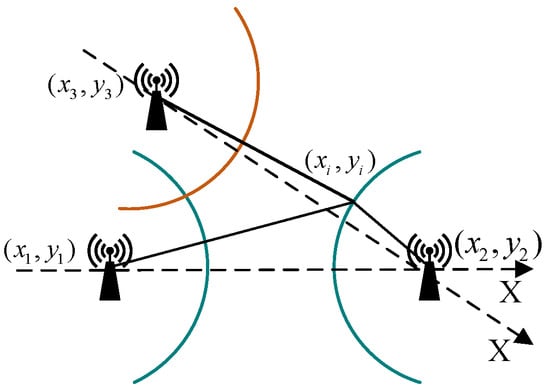
Figure 6.
Schematic diagram of time-of-arrival position estimation.
4.2. Based on Non-Ranging
The positioning method based on RSSI distance measurement mainly utilizes the variation of RSSI propagation in space, so its performance in line-of-sight range is better than that in non-line-of-sight range. As the non-line-of-sight distance is blocked by obstacles and other factors, RSSI will experience obvious attenuation when crossing the barrier, resulting in a decline in positioning accuracy. On this basis, methods such as the approximation method and the database matching method have been proposed successively [33]. The database matching method mainly refers to the application of machine learning, neural network and other technologies in wireless positioning.
4.2.1. Approximation
Figure 7 shows the principal diagram of the approximation of positioning. Let the corresponding position coordinates of three APs be known as (x1, y1), (x2, y2) and (x3, y3) respectively, and the unknown point be (xi, yi). According to the approximation, it is judged which AP (xi, yi) is within the coverage of, then the coordinates of the unknown point are considered to be approximated as the position of the coordinate point of that AP [34]. The schematic diagram of the approximation positioning is shown in Figure 7.
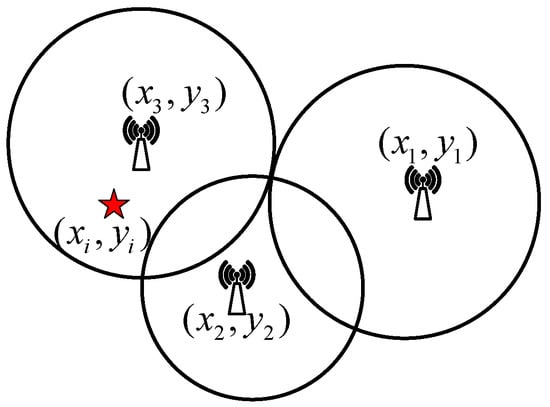
Figure 7.
Schematic diagram of approximation positioning.
4.2.2. Database Matching Method
Fingerprint positioning methods can be generally divided into offline and online stages. The offline stage is used to establish a fingerprint map/database [35], and the online stage is the positioning stage, namely, measurement and matching. The positioning area is artificially set up with grid points and the RSSI values corresponding to different WI-FI are measured for each point, i.e., Equation (14) is obtained. After all points are measured, the fingerprint matrix as shown in Equation (15) is obtained. This process is called the fingerprint database establishment.
In the online stage, the MPi is matched with each point in the fingerprint database to determine the final positioning coordinates by measuring the measurement points [36]. Figure 8 shows the schematic diagram of fingerprint positioning. The most commonly used positioning algorithm in fingerprint positioning is the KNN algorithm; fingerprint points are designed in the offline phase and the RSSI data of the AP is obtained at each fingerprint point to build a fingerprint database. The online phase matches the measurement data obtained from the point to be measured with the fingerprint library, calculates the Euclidean distance from each reference point to the point to be measured, sets the value of k, selects the k coordinates closest to MPi, and ultimately obtains the coordinates of the point to be measured through Equation (17) [37].

Figure 8.
Schematic diagram of the KNN algorithm.
5. Optimization Methods
The optimization methods for wireless positioning technology can be divided into software optimization and hardware optimization. Figure 9 shows the common wireless positioning optimization method diagram. Hardware optimization commonly includes hardware device selection and parameter optimization, while software optimization methods are mainly related to algorithm optimization, including distance measurement method optimization, database matching method optimization, combination optimization methods, etc.

Figure 9.
Common wireless positioning optimization methods.
5.1. Optimization of Hardware Device
The selection of hardware devices in the positioning method based on RSSI includes WIFI, BLE, ZigBee, LoRA, etc. In complex environments, different types of hardware devices can be used to effectively improve the accuracy of positioning [38], and the positioning effect can also be optimized by exploring ways to support different communication protocols, communication frequencies, and communication devices.
In [39], examining the difference in signal characteristics between 2.4 GHz and 5 GHz, the influence of combined frequency of WIFI 2.4 GHz and 5 GHz on positioning accuracy was studied, and the results showed that the success rate of dual-frequency was higher than that of single-frequency. In [40], a 2.4 GHz ISM band LoRa indoor positioning method based on RSSI was proposed. By changing the configuration parameters of LoRa, this method used Matlab to fit the RSSI path loss function of different indoor environments and realized location estimation by using trilateral positioning. LOS and Non-Line of Sight (NLOS) positioning errors under different configuration parameters are analyzed.
In [41], BLE as a beacon is used to explore the differences that exist in the measurement RSSI of different brands of cell phones from the client phone, a new Statistic Similarity Loss (SSL) is proposed to enable the model to be generalized to an unknown phone using a semi-supervised learning method, which was demonstrated by testing the model on a known iPhone XR and an unknown Huawei Mate20 Pro phone; the error of the iPhone XR reached 0.84 m, and Mate20 Pro reduced from 2.62 m to 1.63 m.
In addition, two or more types of equipment are mixed to make full use of the complementary advantages between various devices to achieve the purpose of improving positioning accuracy. Taking WIFI as an example, in [42], a location method combining WIFI and BLE was proposed. In [43], a multi-fusion positioning technique based on convolutional neural network by mixing WIFI with BLE and pedestrian trajectory projection is put forward. Both of the above methods achieved relatively good positioning results. Common hardware optimization methods are shown in Figure 10.
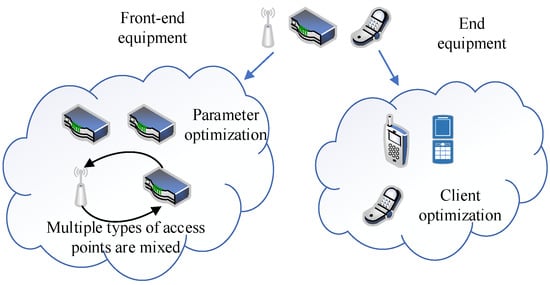
Figure 10.
Common Hardware Optimization Methods Graph.
5.2. Optimization Based on Ranging Methods
The optimization of RSSI’s range-based positioning method is usually employed to improve the signal propagation function and geometric positioning, which is obviously affected by the environment and is mainly applied in the LOS range. The general RSSI path propagation function optimization plot is given in Figure 11. Through the research into the RSSI propagation law, the fitting method is selected and designed to achieve the purpose of improving the fitting accuracy. The commonly used fitting methods are least squares fitting, polynomial fitting, logarithmic fitting, etc.
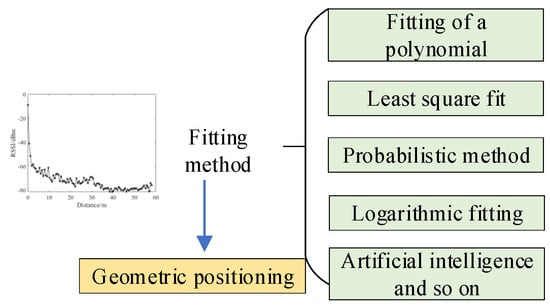
Figure 11.
General RSSI path propagation function optimization plot.
In [44], the RSSI of Bluetooth iBeacon was used for positioning. This method determines the signal propagation model parameters of iBeacon by collecting RSSI values at different distances and performs Kalman filtering on RSSI signals to suppress the signal oscillation and drift. Finally, the weighted least square method and four boundary positioning methods are used to estimate the position of the target object. In [45], the attenuation of RSSI with the change in test distance was studied, and further confirmed that RSSI meets the Gaussian distribution by using the Q-Q diagram and the P-P diagram. On this basis, the function of 1st, 2nd and 3rd degree polynomial fitting RSSI with the change of test distance was studied using logarithm as the variable. Then, the centroid algorithm is proposed through the end point optimization. In [46], it was analyzed that the RSSI distribution has a higher accuracy at a small distance, while the ToA method has a higher accuracy when RSSI is at a long distance. Therefore, a wireless sensor positioning method for TOA-RSSI for a 2D environment was proposed, and the analysis showed that the method had a significant effect.
In [47], wireless positioning technology was applied to UAV (unmanned aerial vehicle) landing, and a prototype UAV ground landing station based on BLE-RSSI was proposed in combination with maximum likelihood estimation and the trilingual measurement algorithm. The results showed that BLU-RSSI could determine the location target more accurately when the UAV was within 5 m of the ground landing station platform.
5.3. Optimization Based on Database Matching Methods
Due to the complexity of RSSI measurement and collection, data sets are usually unevenly distributed, which is mainly manifested in distant points have similar RSSI values [48], which is one of the main reasons for inaccurate positioning of database matching methods. The optimization of database matching method is usually divided into offline database establishment optimization and online database matching optimization.
In [49], an improved KNN fingerprint location method based on error propagation theory was proposed by analyzing the uncertainty of RSSI measurement, and the effectiveness of the algorithm was verified on the open dataset. In [50], the influence of different K values of KNN and WKNN on WIFI fingerprint positioning system was explored, and the optimal fingerprint positioning parameters using the NN algorithm were obtained.
In [51], a wireless positioning method was proposed to quantify and identify AP by introducing non-uniform quantization RSSI entropy into KNN positioning. The construction of an offline fingerprint database selects APs with obvious signal performance differences. The entropy weight Euclidean distance is used as the weight of the similarity between the online RSSI vector and the offline reference point, and the position estimation coordinates are output. This method can reduce the storage overhead and simultaneously improve the positioning accuracy. In [52], an Empirical Mode Decomposition Threshold (EMDT) was proposed to solve the problem of RSSI signal fluctuation. The method first preprocesses the RSSI fingerprint data using the EMDT method and proposes an improved WKNN algorithm, which first obtains the K initial RPs by WKNN, then calculates the center coordinates of the K RPs and the Euclidean distance dic from each coordinate to the center coordinate. The threshold value D is set. When dic > D, the point is considered to be a deviation point, which is culled to obtain the closest coordinates distance of K′. Then, the position of the center point is calculated again along with the distance d′ic to the center point of the new K′ coordinate to derive the new weighted Equation (17). Finally, the improved WKNN method is used for location estimation.
In which, .
In [53], the quadtree algorithm is used to divide the location region in the offline stage and the partitioned data is stored in the form of grid. The online stage utilizes quad-tree search locking to narrow down the positioning range and analyzes the RSSI propagation distance differences in different directions. Taking Figure 12 as an example, it can be seen that the change in RSSI of AP in the x-direction is significantly larger than the change in the y-direction. Based on this, the RSSI Euclidean distance is improved by using the correlation coefficient to determine the nearest K reference points, combined finally with the idea of entropy weight for positioning. Unlike the previous method in [53] where regions are divided, in [54] the K-Means algorithm was used to divide the environment into different logarithmic distance propagation models in order to better characterize the indoor environment, and Bayesian location estimation was improved to obtain positioning results. The results showed that this method was superior to traditional Bayesian location estimation.
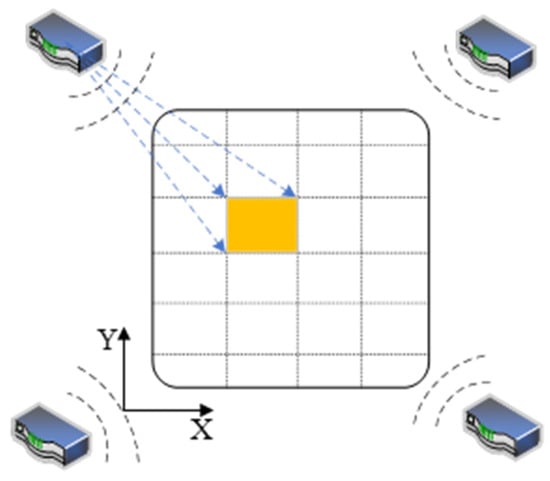
Figure 12.
Difference in propagation distance of RSSI in different directions.
5.4. Combined Optimization
Although a single wireless positioning method has been well developed, it still has certain limitations [55]. The combination positioning method can fully consider the advantages of each single positioning method to design an effective fusion algorithm to improve the positioning accuracy.
5.4.1. Combined with Inertial Sensor
The inertial sensor can calculate the navigation position by measuring motion acceleration, gyroscope, etc., which is one of the more common optimization methods combined with RSSI positioning [56].
In [57], a positioning method combining Pedestrian Dead Reckoning (PDR) and RSSI is designed to address the issues of insufficient positioning accuracy and strong interference in single-source positioning. This method takes advantage of the relatively accurate nature of PDR in short-range positioning and uses the fluctuation of Bluetooth RSSI as a judgment criterion to determine whether to perform adaptive particle filtering. If the criterion is not met, the PDR value is directly outputted. Otherwise, the positioning result is outputted after adaptive particle filtering. In [58], the attenuation of RSSI is more pronounced when passing through room doors, which are used as landmarks in the indoor environment. By accurately monitoring the time when users pass through the doors, this compensates for errors in the cumulative inertial measurement unit (IMU) data so as to achieve the goal of improving positioning accuracy. In [59], a fusion positioning method of WIFI and IUM based on the ESKF algorithm was proposed to achieve high-precision positioning of UAV indoor navigation.
5.4.2. Integration with Image-Based Methods
Image-based wireless positioning methods employ neural networks, machine learning, and other methods for scene recognition to further reduce the positioning area in order to improve the positioning accuracy. There are also positioning corrections by using individual iconic objects as landmarks, while there are methods, such as image matching, plotting the collected RSSI information into grayscale images. Taking Figure 13 as an example, the neural network is used to identify the corridor, elevator entrance and room as the positioning range, and then complete accurate positioning [60].
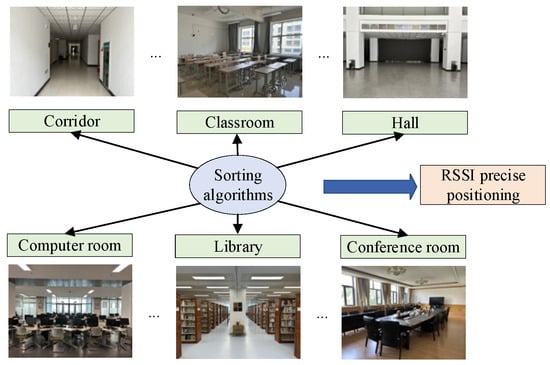
Figure 13.
Positioning scenario diagram.
5.4.3. Methods Combined with Neural Networks
Neural networks and machine learning, as one of the most important research directions in recent years, have been applied to the field of wireless positioning [61]. As one of the most widely used neural networks, the BP neural network is mainly composed of input layer, hidden layer and output layer. Figure 14 shows the model diagram of the classic BP neural network [62]. In wireless positioning, it is often used for RSSI distance estimation and direct position estimation.
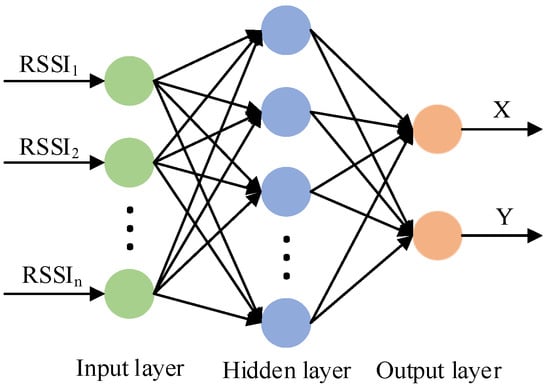
Figure 14.
Model diagram of classical BP neural network.
In [63], the virtual ratio is calculated using the principle of trilateral positioning, on the basis of the RSSI path loss function, narrows the positioning range to set the virtual AP position, and adaptively modifies the inputs of the CNN model in order to improve the positioning accuracy. In [64], a ranging model based on the BP neural network was proposed. This model firstly scales and transforms the collected RSSI by using Equation (18). Secondly, it optimizes the initial values of weights and deviations of the BP neural network by using the genetic algorithm to optimize the ranging model. Lastly, the three sides are positioned to output the positioning results.
where vi and σi denote the average value and standard deviation, namely, the translation and scaling coefficients, respectively.
Based on the optimization of the BP neural network by the genetic algorithm, in [65], an indoor positioning algorithm based on the SAGA BP neural network is combined with simulated annealing to optimize the initial weights and thresholds of the BP neural network. The proposed algorithm is superior to the traditional BP neural network algorithm and GA-BP, analyzing the RSSI loss model and path, RSSI distribution in a simulation room and comparison between simulation and real environment.
In addition, parameter optimization of the neural network occurs. In [66], an optimization method for indoor localization parameters for portable small embedded systems is described in more detail. The method is given a set of machine learning models in advance and searches for optimal parameters by gradually adjusting the number of layers, neurons, and the training number of the models for improvement in positioning accuracy.
In addition to BP neural network, CNN, RNN, LSTM and other models have also been applied to RSSI positioning. In [67], WIFI in a building is used as an access point and Kullback–Leibler scatter is combined to propose a speed-aware recurrent neural network for RSSI fault tolerance, mainly to improve the positioning accuracy when the input access point fails. Experimental comparison results show that this method effectively improves the positioning accuracy. In [68], a random neural network model based on LoRa WAN RSSI was trained and tested using different numbers of neurons. The experiments recorded an average error of learning rate of 0.0002, 0.002, 0.02, 0.2, 2 for 8, 16, 20 hidden neurons, respectively. The results show that the accuracy is higher when the hidden layer neurons are 20 and the learning rate is 0.2.
Table 1 shows the common combinatorial optimization methods; RSSI data sources of RSSI based wireless positioning technology can come from Wi-Fi, BLE, Zigbee and simulation acquisition, etc. UWB, IMU image and LIDAR can be combined with this. These combinations can moderately improve the shortcomings of single positioning but may also lead to an increase in cost and power consumption.

Table 1.
Common combination optimization methods.
6. Data Acquisition
Accurate positioning not only requires a good positioning method but is also crucial to obtain accurate RSSI experimental data [79]. In this section, the methods for RSSI data acquisition, existing problems and optimization methods are discussed.
6.1. Simulation Data
In [80], multi-wall and ray-tracing techniques are used to create three different indoor environment plan simulation RSSI datasets for stadium, office building and a long corridor. Differences between simulated and measured RSSI plots are presented and discussed, and the results show that satisfactory results are also obtained by using simulated models. The RSSI map generated using ray tracing technique is given in Figure 15.
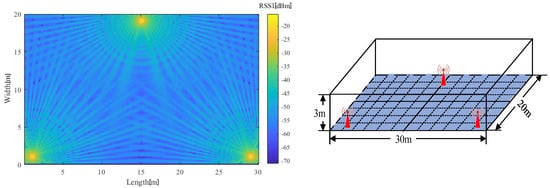
Figure 15.
The RSSI map generated using ray tracing technique.
In addition to obtaining RSSI simulation data by ray-tracing technology, attenuation functions can also be obtained by fitting RSSI with distance attenuation, so as to obtain RSSI values of reference points and test points [81].
6.2. Real Data Acquisition
Figure 16 shows the basic block diagram for data acquisition. The RSSI data acquisition grid points were designed in the collection area, and mobile devices, such as smart phones, were used to perform multiple RSSI acquisitions at the grid points to establish the RSSI database.
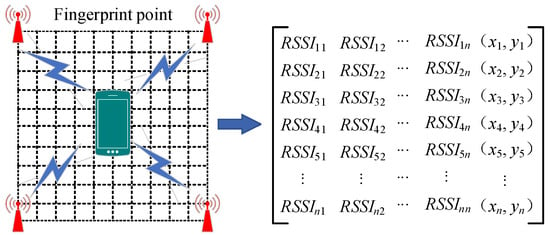
Figure 16.
Basic block diagram of data acquisition.
Figure 17 shows the RSSI distribution of the APs at three different positions measured in a 7.0 × 6.2 environment. The acquisition cell phone was SAMSUNG Galaxy S20, and the completion of the acquisition was carried out at intervals of 0.6 m.
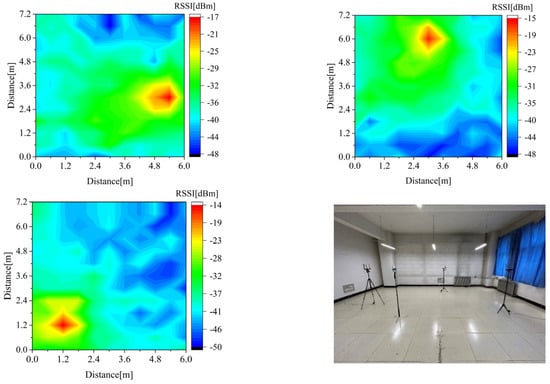
Figure 17.
Signal strength distribution of different WIFIs.
Based on previous research, a higher level of positioning accuracy can be achieved by reducing the interval between sampling points. To obtain a higher accuracy of positioning, a large number of collected data need to be obtained, thus increasing the time and cost of data collection to a certain extent [82]. Based on this, many researchers have carried out a series of explorations. By designing the trajectory and speed of the robot, the purpose of uniform data acquisition can be achieved and labor costs can be reduced [83]. Software algorithms can utilize interpolation, SLAM, migration learning and other methods for data reconstruction to improve data collection efficiency.
Fingerprint datasets will change as the environment changes, so the fingerprint database needs to be updated regularly, which is also a part of the cost of wireless positioning [84]. In [85], an RSSI fingerprint change detection method using machine learning techniques to reconstruct the RSSI database into a probabilistic feature database by PCA (Principal Component Analysis) and GP (Gaussian Process) is described. This method uses KL (Kullback–Leibler) divergence as a metric to measure the similarity between the existing database and the new test set, so as to determine whether the fingerprint database needs to be updated.
In [86], a biharmonic spline interpolation method was proposed to expand the amount of wireless map data based on the original data collection. Combined with Feedforward Backpropagation (FFBP) Neural Network and General Regression Neural Network (GRNN), the position estimation of an artificial neural network based on a semi-interpolating database is designed. The experiment results show that the method has a good effect.
6.3. Publicly Available Datasets
A good dataset can effectively improve the efficiency of positioning algorithm validation and increase the algorithm validation pathways [87]. With the increase in the number of researchers in RSSI wireless positioning, many scholars have shared the measured datasets to facilitate the experimental testing of the algorithms, which has pushed the development of wireless positioning technology. Selected RSSI datasets are given in Table 2.

Table 2.
RSSI datasets.
7. Remaining Problems and Development Trends
7.1. Current Challenges
Although wireless positioning technology has been significantly developed, there is still a large room for improvement. Taking the RSSI positioning technique as an example, there are many interfering factors in the spatial propagation of RSSI [93], which lead to a certain degree of error, either by using database matching or by using a distance-based model [94]. How to effectively address this error due to communication propagation requires further research and exploration. In terms of algorithm improvement, many artificial intelligence algorithms have been applied to wireless positioning technology, and the positioning accuracy has been improved to different degrees. To obtain high positioning accuracy through machine learning and neural network requires much training, which will inevitably lead to an increase in computing costs. In the case of BP neural networks, the algorithm is more likely to fall into a local optimum, which will lead to suboptimal training parameters. Meanwhile, there is also literature on various improvements in terms of loss function, number of neurons, number of layers, etc., to improve the positioning accuracy. WIFI, Bluetooth, and inertial sensors, as the most common devices in people’s lives, when used in wireless positioning can greatly reduce the cost of positioning [95]. How to effectively utilize these low-cost, easy-to-deploy devices to achieve higher-precision positioning is still a challenge that many scholars need to overcome.
7.2. Development Trends
With the further development of wireless communication technology, the development of emerging industries, such as smart cities, intelligent robots and driverless cars, is also growing. Location-based services will play an increasingly important role in people’s lives [96]. Artificial intelligence algorithms, such as machine learning and neural networks, will be widely used in wireless positioning technology in the future [97]. The proposed new algorithm will promote wireless positioning technology in the software to achieve greater breakthroughs, and the integration of multi-algorithm and multi-technology will also promote higher precision in wireless positioning, lower cost, higher applicability, more portability and intelligent direction.
8. Conclusions
Focusing on the application of wireless positioning technology and related evaluation methods, this paper mainly analyzes the relationship between RSSI and distance change in spatial communication. On this basis, the wireless positioning method based on distance and database matching method is introduced in more detail. The advantages and disadvantages of several methods and the corresponding improvements are analyzed. The methods of obtaining simulation data and real data for wireless positioning research are explained. Finally, the problems and development trends in wireless positioning technology are explained, and the necessity of further research is pointed out, which provides reference for subsequent research.
Author Contributions
Writing—original draft preparation, B.C.; writing—review and editing, L.Z., J.Z., J.F. and H.L.; supervision, J.M. All authors have read and agreed to the published version of the manuscript.
Funding
This research was funded by the Natural Science Foundation of in Qinghai Province, grant number 2021-ZJ-916.
Data Availability Statement
Data sharing is not applicable.
Conflicts of Interest
The authors declare no conflicts of interest.
References
- Asaad, S.M.; Maghdid, H.S. Novel integrated matching algorithm using a deep learning algorithm for Wi-Fi fingerprint-positioning technique in the indoors-IoT era. PeerJ Comput. Sci. 2023, 9, e1406. [Google Scholar] [CrossRef]
- Li, C.T.; Cheng, J.C.; Chen, K. Top 10 technologies for indoor positioning on construction sites. Autom. Constr. 2020, 118, 103309. [Google Scholar] [CrossRef]
- Filus, K.; Nowak, S.; Domańska, J.; Duda, J. Cost-effective filtering of unreliable proximity detection results based on BLE RSSI and IMU readings using smartphones. Sci. Rep. 2022, 12, 2440. [Google Scholar] [CrossRef]
- Feng, P.; Qin, D.; Zhao, M.; Guo, R.; Berhane, T.M. Unsupervised Indoor Positioning System Based on Environmental Signatures. Entropy 2019, 21, 327. [Google Scholar] [CrossRef]
- Zhang, W.; Yang, X. DV-Hop Location Algorithm Based on RSSI Correction. Electronics 2023, 12, 1141. [Google Scholar] [CrossRef]
- Han, Z.; Wang, Z.; Huang, H.; Zhao, L.; Su, C. WiFi-Based Indoor Positioning and Communication: Empirical Model and Theoretical Analysis. Wirel. Commun. Mob. Comput. 2022, 2022, 2364803. [Google Scholar] [CrossRef]
- Lee, H.; Lee, J. Convolutional Model with a Time Series Feature Based on RSSI Analysis with the Markov Transition Field for Enhancement of Location Recognition. Sensors 2023, 23, 3453. [Google Scholar] [CrossRef]
- Biswas, D.; Barai, S.; Sau, B. New RSSI-fingerprinting-based smartphone localization system for indoor environments. Wirel. Netw. 2023, 29, 1281–1297. [Google Scholar] [CrossRef]
- Poulose, A.; Han, D.S. Hybrid Deep Learning Model Based Indoor Positioning Using Wi-Fi RSSI Heat Maps for Autonomous Applications. Electronics 2021, 10, 2. [Google Scholar] [CrossRef]
- Booranawong, A.; Thammachote, P.; Sasiwat, Y.; Auysakul, J.; Sengchuai, K.; Buranapanichkit, D.; Tanthanuch, S.; Jindapetch, N.; Saito, H. Real-time tracking of a moving target in an indoor corridor of the hospital building using RSSI signals received from two reference nodes. Med. Biol. Eng. Comput. 2022, 60, 439–458. [Google Scholar] [CrossRef]
- Liu, M.; Zhang, Z.; Chen, Y.; Ge, J.; Zhao, N. Adversarial Attack and Defense on Deep Learning for Air Transportation Communication Jamming. IEEE Trans. Intell. Transp. Syst. 2023. [Google Scholar] [CrossRef]
- Oryad, F.E.; Amindavar, H. Wireless positioning based on hierarchical symbolic dynamic filtering of RSSI time series. Signal Process. 2023, 206, 108903. [Google Scholar] [CrossRef]
- Biswas, D.; Barai, S.; Sau, B. Enhanced RSSI-Based Real-Time Position-Tracking System in Vehicular Networks. IEEE Sensors Lett. 2022, 6, 7500604. [Google Scholar] [CrossRef]
- Wattananavin, T.; Auysakul, J.; Tanthanuch, S.; Buranapanichkit, D.; Sengchuai, K.; Jindapetch, N.; Booranawong, A. How Acquired Log-Distance Path-Loss Equations Affect the Accuracy of Lateration and WCL Methods: An Experimental Comparison. J. Electr. Eng. Technol. 2023, 18, 599–614. [Google Scholar] [CrossRef]
- Deng, S.; Zhang, W.; Xu, L.; Yang, J. RRIFLoc: Radio Robust Image Fingerprint Indoor Localization Algorithm Based on Deep Residual Networks. IEEE Sensors J. 2022, 23, 3233–3242. [Google Scholar] [CrossRef]
- Yu, X.; Wang, S.; Xiao, F. Applications of Nondominated Sorting Genetic Algorithm II Combined with WKNN Online Matching Algorithm in Building Indoor Optimization Design. Comput. Intell. Neurosci. 2022, 2022, 7509659. [Google Scholar] [CrossRef]
- Oda, M.; Takyu, O.; Ohta, M.; Fujii, T.; Adachi, K. Position Estimation of Radio Source Based on Fingerprinting with Physical Wireless Parameter Conversion Sensor Networks. IEEE Access 2023, 11, 12843–12857. [Google Scholar] [CrossRef]
- Csik, D.; Odry, Á.; Sarcevic, P. Fingerprinting-Based Indoor Positioning Using Data Fusion of Different Radiocommunication-Based Technologies. Machines 2023, 11, 302. [Google Scholar] [CrossRef]
- Achroufene, A. RSSI-based geometric localization in wireless sensor networks. J. Supercomput. 2023, 79, 5615–5642. [Google Scholar] [CrossRef]
- Wandell, R.; Hossain, S.; Hussain, I. A cost-effective Wi-Fi-based indoor positioning system for mobile phones. Wirel. Netw. 2023, 29, 2845–2862. [Google Scholar] [CrossRef]
- Rayavarapu, V.; Mahapatro, A. MOANS DV-Hop: An anchor node subset based localization algorithm for wireless sensor networks. Ad Hoc Networks 2024, 152, 103323. [Google Scholar] [CrossRef]
- Subhan, F.; Ahmed, S.; Ashraf, K.; Zhang, X. Extended Gradient Predictor and Filter for smoothing RSSI. In Proceedings of the 16th International Conference on Advanced Communication Technology, Pyeongchang, Republic of Korea, 16–19 February 2014; pp. 1198–1202. [Google Scholar] [CrossRef]
- Kumar, V.; Arablouei, R.; de Hoog, F.; Jurdak, R.; Kusy, B.; Bergmann, N.W. Pseudo-linear localization using perturbed RSSI measurements and inaccurate anchor positions. Pervasive Mob. Comput. 2019, 52, 46–59. [Google Scholar] [CrossRef]
- Ayabakan, T.; Kerestecioglu, F. RSSI-Based Indoor Positioning via Adaptive Federated Kalman Filter. IEEE Sensors J. 2022, 22, 5302–5308. [Google Scholar] [CrossRef]
- Ibnatta, Y.; Khaldoun, M.; Sadik, M. Indoor Localization System Based on Mobile Access Point Model MAPM Using RSS with UWB-OFDM. IEEE Access 2022, 10, 46043–46056. [Google Scholar] [CrossRef]
- Gu, T.; Tang, Y.; Wang, Z.; Lan, R.; Zhong, Y.; Chang, L. The Indoor Positioning Fusion Algorithm of Multi-source and Heterogeneous. In Proceedings of the 2018 7th International Conference on Digital Home (ICDH), Guilin, China, 30 November–1 December 2018; pp. 294–299. [Google Scholar] [CrossRef]
- Varma, P.S.; Anand, V. ReMAPP: Reverse multilateration based access point positioning using multivariate regression for indoor localization in smart buildings. Telecommun. Syst. 2023, 83, 303–322. [Google Scholar] [CrossRef]
- Huang, J.; Junginger, S.; Liu, H.; Thurow, K. Indoor Positioning Systems of Mobile Robots: A Review. Robotics 2023, 12, 47. [Google Scholar] [CrossRef]
- Kavetha, S.; Ja’Afar, A.S.; Aziz, M.Z.A.; Isa, A.A.M.; Johal, M.S.; Hashim, N.M.Z. Development of location estimation algorithm utilizing rssi for lora positioning system. J. Teknol. Sci. Eng. 2019, 84, 97–105. [Google Scholar] [CrossRef]
- Damayanti, T.N.; Ramadan, D.N.; Utami, I.M. MyLib: Smart Library Indoor Navigation Using Bluetooth Low Energy with Triangulation Method. Int. J. Electron. Telecommun. 2022, 68, 293–298. [Google Scholar] [CrossRef]
- Yaro, A.S.; Maly, F.; Prazak, P. A Survey of the Performance-Limiting Factors of a 2-Dimensional RSS Fingerprinting-Based Indoor Wireless Localization System. Sensors 2023, 23, 2545. [Google Scholar] [CrossRef]
- Kim, J. Suppression of NLOS errors in TDOA-AOA hybrid localization. Wirel. Netw. 2023, 29, 657–667. [Google Scholar] [CrossRef]
- Lee, S.-H.; Kim, W.-Y.; Seo, D.-H. Automatic self-reconstruction model for radio map in Wi-Fi fingerprinting. Expert Syst. Appl. 2022, 192, 116455. [Google Scholar] [CrossRef]
- Bilodeau, J.-S.; Bouzouane, A.; Bouchard, B.; Gaboury, S. An experimental comparative study of RSSI-based positioning algorithms for passive RFID localization in smart environments. J. Ambient Intell. Humaniz. Comput. 2018, 9, 1327–1343. [Google Scholar] [CrossRef]
- Shin, B.; Lee, J.H.; Yu, C.; Kyung, H.; Lee, T. Simultaneous Localization and Mapping for Pedestrians using Radio Frequency Signals. IEEE Sensors J. 2022, 22, 13497–13507. [Google Scholar] [CrossRef]
- Zhang, X.; Zhang, S.; Wang, C.; Sun, S. Regional Double-Layer, High-Precision Indoor Positioning System Based on iBeacon Network. Math. Probl. Eng. 2022, 2022, 8673083. [Google Scholar] [CrossRef]
- Yu, M.; Yao, S.; Wu, X.; Chen, L. Research on a Wi-Fi RSSI Calibration Algorithm Based on WOA-BPNN for Indoor Positioning. Appl. Sci. 2022, 12, 7151. [Google Scholar] [CrossRef]
- Naghdi, S.; O’keefe, K. Combining Multichannel RSSI and Vision with Artificial Neural Networks to Improve BLE Trilateration. Sensors 2022, 22, 4320. [Google Scholar] [CrossRef]
- Ozdemir, B.N.; Ceylan, A. Constructing a precise radio map and application of indoor positioning with dual-frequency Wi-Fi fingerprinting method. Measurement 2020, 163, 107997. [Google Scholar] [CrossRef]
- Simka, M.; Polak, L. On the RSSI-Based Indoor Localization Employing LoRa in the 2.4 GHz ISM Band. Radioengineering 2022, 31, 135–143. [Google Scholar] [CrossRef]
- Harsh, A.; Navyata, S.; Vivek, R.; Kris, K. DeepBLE: Generalizing RSSI-based localization across different devices. arXiv 2021. [Google Scholar] [CrossRef]
- Haznedar, Y.; Aydin, G.Z.G.; Turgut, Z. Hybrid indoor positioning for smart homes using WiFi and Bluetooth low energy technologies. J. Ambient Intell. Smart Environ. 2023, 15, 63–87. [Google Scholar] [CrossRef]
- Tian, Z.; Xiao, Z.; Huang, Y. Multi-Source Fusion Localization Technology Based on Convolutional Neural Networks. In Proceedings of the 2022 14th International Conference on Wireless Communications and Signal Processing (WCSP), Nanjing, China, 1–3 November 2022; pp. 1081–1085. [Google Scholar] [CrossRef]
- Zhou, C.; Yuan, J.; Liu, H.; Qiu, J. Bluetooth Indoor Positioning Based on RSSI and Kalman Filter. Wirel. Pers. Commun. 2017, 96, 4115–4130. [Google Scholar] [CrossRef]
- Yang, J.; Feng, Z.; Ma, X.; Zhang, X. Indoor Positioning Method Based on Wireless Signal. iJOE Int. J. Online Eng. 2018, 14, 53–67. [Google Scholar] [CrossRef]
- Zaidi, M.; Bouazzi, I.; Usman, M.; Shamim, M.Z.M.; Singh, N.; Gunjan, V.K. Cooperative Scheme ToA-RSSI and Variable Anchor Positions for Sensors Localization in 2D Environments. Complexity 2022, 2022, 5069254. [Google Scholar] [CrossRef]
- Avilés-Viñas, J.; Carrasco-Alvarez, R.; Vázquez-Castillo, J.; Ortegón-Aguilar, J.; Estrada-López, J.J.; Jensen, D.D.; Peón-Escalante, R.; Castillo-Atoche, A. An Accurate UAV Ground Landing Station System Based on BLE-RSSI and Maximum Likelihood Target Position Estimation. Appl. Sci. 2022, 12, 6618. [Google Scholar] [CrossRef]
- Lin, H.; Purmehdi, H.; Fei, X.; Zhao, Y.; Isac, A.; Louafi, H.; Peng, W. Two-stage clustering for improve indoor positioning accuracy. Autom. Constr. 2023, 154, 104981. [Google Scholar] [CrossRef]
- Pérez-Navarro, A.; Montoliu, R.; Sansano-Sansano, E.; Martínez-Garcia, M.; Femenía, R.; Torres-Sospedra, J. Accuracy of a Single Position Estimate for kNN-Based Fingerprinting Indoor Positioning Applying Error Propagation Theory. IEEE Sensors J. 2023, 23, 18765–18775. [Google Scholar] [CrossRef]
- Ebaid, E.; Navaie, K. Optimum NN Algorithms Parameters on the UJIIndoorLoc for Wi-Fi Fingerprinting Indoor Positioning Systems. In Proceedings of the 2022 32nd International Telecommunication Networks and Applications Conference (ITNAC), Wellington, New Zealand, 30 November–2 December 2022; pp. 280–286. [Google Scholar] [CrossRef]
- Li, H.; Qian, Z.; Liu, G.; Wang, X. NQRELoc: AP Selection via Nonuniform Quantization RSSI Entropy for Indoor Localization. IEEE Sensors J. 2022, 22, 9724–9732. [Google Scholar] [CrossRef]
- Zhou, R.; Meng, F.; Zhou, J.; Teng, J. A Wi-Fi Indoor Positioning Method Based on an Integration of EMDT and WKNN. Sensors 2022, 22, 5411. [Google Scholar] [CrossRef]
- Huang, Y.; Ye, R.; Yan, B.; Zhang, C.; Zhou, X. QSFDEW: A fingerprint positioning method based on quadtree search and fractal direction entropy weighting. Wirel. Netw. 2023, 29, 437–448. [Google Scholar] [CrossRef]
- Pinto, B.; Barreto, R.; Souto, E.; Oliveira, H. Robust RSSI-Based Indoor Positioning System Using K-Means Clustering and Bayesian Estimation. IEEE Sensors J. 2021, 21, 24462–24470. [Google Scholar] [CrossRef]
- Wang, T.; Han, L.; Kong, Q.; Li, Z.; Li, C.; Han, J.; Bai, Q.; Chen, Y. An improved particle filter indoor fusion positioning approach based on Wi-Fi/PDR/geomagnetic field. Def. Technol. 2023, in press. [Google Scholar] [CrossRef]
- Mehrabian, H.; Ravanmehr, R. Sensor fusion for indoor positioning system through improved RSSI and PDR methods. Futur. Gener. Comput. Syst. 2023, 138, 254–269. [Google Scholar] [CrossRef]
- Li, M.; Zhu, R.; Ding, Q.; Wang, J.; Wan, S.; Ma, M. Edge computing-enabled green multisource fusion indoor positioning algorithm based on adaptive particle filter. Clust. Comput. J. Netw. Softw. Tools Appl. 2022, 26, 667–684. [Google Scholar] [CrossRef]
- Choi, J.; Lee, G.; Choi, S.; Bahk, S. Smartphone Based Indoor Path Estimation and Localization Without Human Intervention. IEEE Trans. Mob. Comput. 2022, 21, 681–695. [Google Scholar] [CrossRef]
- Li, Z.; Zhang, Y. Constrained ESKF for UAV Positioning in Indoor Corridor Environment Based on IMU and WiFi. Sensors 2022, 22, 391. [Google Scholar] [CrossRef]
- Labinghisa, B.A.; Lee, D.M. Indoor localization system using deep learning based scene recognition. Multimedia Tools Appl. 2022, 81, 28405–28429. [Google Scholar] [CrossRef]
- Bellavista-Parent, V.; Torres-Sospedra, J.; Perez-Navarro, A. New trends in indoor positioning based on WiFi and machine learning: A systematic review. In Proceedings of the 2021 International Conference on Indoor Positioning and Indoor Navigation (IPIN), Lloret de Mar, Spain, 29 November–2 December 2021. [Google Scholar] [CrossRef]
- Fei, R.; Guo, Y.; Li, J.; Hu, B.; Yang, L. An Improved BPNN Method Based on Probability Density for Indoor Location. IEICE Trans. Inf. Syst. 2023, E106.D, 773–785. [Google Scholar] [CrossRef]
- Wu, S.; Huang, W.; Li, M.; Xu, K. A Novel RSSI Fingerprint Positioning Method Based on Virtual AP and Convolutional Neural Network. IEEE Sensors J. 2022, 22, 6898–6909. [Google Scholar] [CrossRef]
- Lin, Y.; Yu, K.; Hao, L.; Wang, J.; Bu, J. An Indoor Wi-Fi Localization Algorithm Using Ranging Model Constructed with Transformed RSSI and BP Neural Network. IEEE Trans. Commun. 2022, 70, 2163–2177. [Google Scholar] [CrossRef]
- Wang, W.; Zhu, Q.; Wang, Z.; Zhao, X.; Yang, Y. Research on Indoor Positioning Algorithm Based on SAGA-BP Neural Network. IEEE Sensors J. 2022, 22, 3736–3744. [Google Scholar] [CrossRef]
- Kotrotsios, K.; Fanariotis, A.; Leligou, H.-C.; Orphanoudakis, T. Design Space Exploration of a Multi-Model AI-Based Indoor Localization System. Sensors 2022, 22, 570. [Google Scholar] [CrossRef]
- Varma, P.S.; Anand, V. Fault-Tolerant indoor localization based on speed conscious recurrent neural network using Kullback–Leibler divergence. Peer-to-Peer Netw. Appl. 2022, 15, 1370–1384. [Google Scholar] [CrossRef]
- Ingabire, W.; Larijani, H.; Gibson, R.M.; Qureshi, A.-U. LoRaWAN Based Indoor Localization Using Random Neural Networks. Information 2022, 13, 303. [Google Scholar] [CrossRef]
- Sarcevic, P.; Csik, D.; Odry, A. Indoor 2D Positioning Method for Mobile Robots Based on the Fusion of RSSI and Magnetometer Fingerprints. Sensors 2023, 23, 1855. [Google Scholar] [CrossRef]
- Long, Q.; Zhang, J.; Cao, L.; Wang, W. Indoor Visible Light Positioning System Based on Point Classification Using Artificial Intelligence Algorithms. Sensors 2023, 23, 5224. [Google Scholar] [CrossRef]
- Ge, G.; Qin, Z.; Chen, X. Integrating WSN and Laser SLAM for Mobile Robot Indoor Localization. Comput. Mater. Contin. 2023, 74, 6351–6369. [Google Scholar] [CrossRef]
- Ge, G.; Li, J.; Qin, Z. Mobile Robot Localization in Geometrically Similar Environment Combining Wi-Fi with Laser SLAM. KSII Trans. Internet Inf. Syst. 2023, 17, 1339–1355. [Google Scholar] [CrossRef]
- Jin, Z.; Li, Y.; Yang, Z.; Zhang, Y.; Cheng, Z. Real-Time Indoor Positioning Based on BLE Beacons and Pedestrian Dead Reckoning for Smartphones. Appl. Sci. 2023, 13, 4415. [Google Scholar] [CrossRef]
- Nurpeiissov, M.; Kuzdeuov, A.; Assylkhanov, A.; Khassanov, Y.; Varol, H.A. End-to-End Sequential Indoor Localization Using Smartphone Inertial Sensors and WiFi. In Proceedings of the 2022 IEEE/SICE International Symposium on System Integration (SII), Narvik, Norway, 9–12 January 2022; pp. 566–571. [Google Scholar] [CrossRef]
- Mihara, S.; Murakami, T.; Yamaguchi, A.; Shinbo, H. User Equipment Tracking for a Millimeter Wave System Using Vision and RSSI. IEEE Open J. Commun. Soc. 2022, 3, 1563–1577. [Google Scholar] [CrossRef]
- Chong, A.-M.; Yeo, B.-C.; Lim, W.-S. Integration of UWB RSS to Wi-Fi RSS fingerprinting-based indoor positioning system. Cogent Eng. 2022, 9, 2087364. [Google Scholar] [CrossRef]
- Talla-Chumpitaz, R.; Castillo-Cara, M.; Orozco-Barbosa, L.; García-Castro, R. A novel deep learning approach using blurring image techniques for Bluetooth-based indoor localisation. Inf. Fusion 2023, 91, 173–186. [Google Scholar] [CrossRef]
- Lee, K.; Nam, Y.; Min, S.D. An indoor localization solution using Bluetooth RSSI and multiple sensors on a smartphone. Multimedia Tools Appl. 2018, 77, 12635–12654. [Google Scholar] [CrossRef]
- Scavino, E.; Rahman, M.A.A.; Farid, Z. An Improved Hybrid Indoor Positioning Algorithm via QPSO and MLP Signal Weighting. Comput. Mater. Contin. 2023, 74, 379–397. [Google Scholar] [CrossRef]
- Kawecki, R.; Hausman, S.; Korbel, P. Performance of Fingerprinting-Based Indoor Positioning with Measured and Simulated RSSI Reference Maps. Remote Sens. 2022, 14, 1992. [Google Scholar] [CrossRef]
- Yang, Y.; Dai, P.; Huang, H.; Wang, M.; Kuang, Y. A Semi-Simulated RSS Fingerprint Construction for Indoor Wi-Fi Positioning. Electronics 2020, 9, 1568. [Google Scholar] [CrossRef]
- Sulaiman, B.; Tarapiah, S.; Natsheh, E.; Atalla, S.; Mansoor, W.; Himeur, Y. Radio map generation approaches for an RSSI-based indoor positioning system. Syst. Soft Comput. 2023, 5, 200054. [Google Scholar] [CrossRef]
- Gong, X.; Liu, J.; Yang, S.; Gu, F.; Huang, G.; Bai, Y. An Enhanced Indoor Positioning Solution Using Dynamic Radio Fingerprinting Spatial Context Recognition. IEEE Internet Things J. 2023, 10, 1297–1309. [Google Scholar] [CrossRef]
- Qian, J.; Song, M. Research and Application of Underground WLAN Adaptive Radio Fingerprint Database. Sensors 2020, 20, 1182. [Google Scholar] [CrossRef]
- Yoo, J. Change Detection of RSSI Fingerprint Pattern for Indoor Positioning System. IEEE Sensors J. 2020, 20, 2608–2615. [Google Scholar] [CrossRef]
- Sulaiman, B.; Natsheh, E.; Tarapiah, S. Towards a better indoor positioning system: A location estimation process using artificial neural networks based on a semi-interpolated database. Pervasive Mob. Comput. 2022, 81, 101548. [Google Scholar] [CrossRef]
- Klus, L.; Quezada-Gaibor, D.; Torres-Sospedra, J.; Lohan, E.S.; Granell, C.; Nurmi, J. Towards Accelerated Localization Performance Across Indoor Positioning Datasets. In Proceedings of the 2022 International Conference on Localization and GNSS (ICL-GNSS), Tampere, Finland, 7–9 June 2022. [Google Scholar] [CrossRef]
- Torres-Sospedra, J.; Montoliu, R.; Martinez-Uso, A.; Avariento, J.P.; Arnau, T.J.; Benedito-Bordonau, M.; Huerta, J. UJIIndoorLoc: A new multi-building and multi-floor database for WLAN fingerprint-based indoor localization problems. In Proceedings of the 2014 International Conference on Indoor Positioning and Indoor Navigation (IPIN), Busan, Republic of Korea, 27–30 October 2014. [Google Scholar] [CrossRef]
- Hisham, A.N.N.; Ng, Y.H.; Tan, C.K.; Chieng, D. Hybrid Wi-Fi and BLE Fingerprinting Dataset for Multi-Floor Indoor Environments with Different Layouts. Data 2022, 7, 156. [Google Scholar] [CrossRef]
- Abdullah, A.; Haris, M.; Aziz, O.A.; Rashid, R.A.; Abdullah, A.S. UTMInDualSymFi: A Dual-Band Wi-Fi Dataset for Fingerprinting Positioning in Symmetric Indoor Environments. Data 2023, 8, 14. [Google Scholar] [CrossRef]
- Luckner, M.; Sowik, S.; Brida, P. Selection of Signal Sources Influence at Indoor Positioning System. IEEE Trans. Wirel. Commun. 2024, 23, 45–57. [Google Scholar] [CrossRef]
- Mohammadi, M.; Al-Fuqaha, A.; Guizani, M. Semi-supervised Deep Reinforcement Learning in Support of IoT and Smart City Services. IEEE Internet Things J. 2018, 5, 624–635. [Google Scholar] [CrossRef]
- Eltohamy, A.; Korb, M.; Zetik, R.; Thomä, R.S. Optimum Access-Point Constellation for Indoor Time Difference of Arrival Positioning. In Proceedings of the 2023 IEEE/ION Position, Location and Navigation Symposium (PLANS), Monterey, CA, USA, 24–27 April 2023; pp. 1234–1240. [Google Scholar] [CrossRef]
- Luo, Q.; Yan, X.; Li, J.; Peng, Y.; Tang, Y.; Wang, J.; Wang, D. DEDF: Lightweight WSN distance estimation using RSSI data distribution-based fingerprinting. Neural Comput. Appl. 2016, 27, 1567–1575. [Google Scholar] [CrossRef]
- Chen, H.-C.; Lin, R.-S.; Huang, C.-J.; Tian, L.; Su, X.; Yu, H. Bluetooth-controlled Parking System Based on WiFi Positioning Technology. Sensors Mater. 2022, 34, 1179–1189. [Google Scholar] [CrossRef]
- Yang, J.; Deng, S.; Xu, L.; Zhang, W. Calibration-Free 3D Indoor Positioning Algorithms Based on DNN and DIFF. Sensors 2022, 22, 5891. [Google Scholar] [CrossRef]
- Leitch, S.G.; Bin Abbas, W.; Ahmed, Q.Z.; Hafeez, M.; Lazaridis, P.I. Different Indoor Localisation Techniques using Smartphones. In Proceedings of the 2022 25th International Symposium on Wireless Personal Multimedia Communications (WPMC), Herning, Denmark, 30 October–2 November 2022; pp. 505–509. [Google Scholar] [CrossRef]
Disclaimer/Publisher’s Note: The statements, opinions and data contained in all publications are solely those of the individual author(s) and contributor(s) and not of MDPI and/or the editor(s). MDPI and/or the editor(s) disclaim responsibility for any injury to people or property resulting from any ideas, methods, instructions or products referred to in the content. |
© 2024 by the authors. Licensee MDPI, Basel, Switzerland. This article is an open access article distributed under the terms and conditions of the Creative Commons Attribution (CC BY) license (https://creativecommons.org/licenses/by/4.0/).